Mushrooms
Media
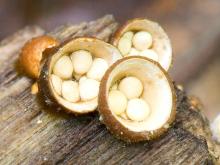
Species Types
Scientific Name
Crucibulum laeve
Description
Splash cups have small brown cups holding tiny “eggs” that are each attached to the “nest” by a cord. They grow in clusters on dead wood, debris, wood chips, and mulch.
Media

Species Types
Scientific Name
Lycoperdon perlatum
Description
The gem-studded puffball is a white, rounded to turban-shaped ball, densely covered with spiny warts, developing a pore at the top. It grows on the ground in open woods, along roads, in waste areas.
Media
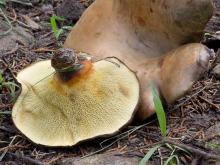
Species Types
Scientific Name
Boletinellus merulioides
Description
The ash tree bolete is a pored mushroom with a brownish, wavy cap, an off-center stalk, and clearly defined pores. It grows scattered on the ground near ash trees.
Media

Species Types
Scientific Name
Polyporus radicatus
Description
The rooting polypore has a scruffy, tough, yellowish-brown cap with whitish-yellow pores, and a stalk with a long, black, rootlike filament. It usually grows singly, on the ground near stumps or attached to buried roots.
Media
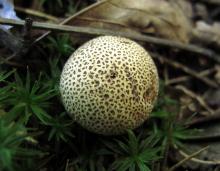
Species Types
Scientific Name
Scleroderma citrinum (Scleroderma aurantium)
Description
The pigskin puffball is a rounded, warted, yellowish brown ball with blackish purple flesh. It grows on the ground, on wood debris, and near trees in woods.
Media

Species Types
Scientific Name
Amanita spp. (about 600 species, worldwide)
Description
This large group of mushrooms accounts for 90 percent of mushroom-related deaths, so every mushroom hunter should be familiar with amanitas. They contain one of the deadliest poisons found in nature!
Media
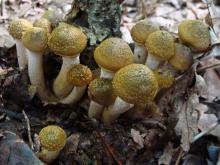
Species Types
Scientific Name
Armillaria mellea
Description
The honey mushroom has a honey-colored, sticky cap with black hairs over the center, and a stalk with a whitish ring. It grows in clusters at the bases of trees or stumps, especially oaks, and over buried wood.
Media
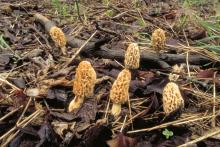
Species Types
Scientific Name
Morchella species
Description
Favorites among Missouri wild edibles, true morels only appear in the spring. They're very hard to see, but that's part of the fun of hunting them. Learn to identify them, and you can enjoy the hunt, too.
Media

Species Types
Scientific Name
Morchella esculentoides (formerly M. esculenta)
Description
The yellow morel is a choice edible mushroom. It has a honeycombed cap with yellow to grayish to tan ridges and pits. It is completely hollow and grows in the spring.
Media

Species Types
Scientific Name
Fuligo septica
Description
In addition to "dog vomit" and "scrambled eggs," this slime mold can also look like the foam at the top of a pint of stout beer, or a yellow or tan sponge. It grows on mulch and other decaying wood.
See Also



Media

Species Types
Scientific Name
Monotropa hypopitys
Description
Pinesap is a plant that puts the "wild" in wildflower! It lacks chlorophyll, so its roots connect to fungi underground and absorb nutrients from the fungi.
Media

Species Types
Scientific Name
Cladophora, Pithophora, and Spirogyra spp., and others
Description
Filamentous green algae forms green, cottony masses that are free-floating or attached to rocks, debris, or other plants.
Media

Species Types
Scientific Name
Monotropa uniflora
Description
Indian pipe lacks chlorophyll, so it is white, not green. Below ground, its roots join with fungi that connect to tree roots. This plant, then, takes nourishment indirectly from the trees.
About Mushrooms in Missouri
Mushrooms are a lot like plants, but they lack chlorophyll and have to take nutrients from other materials. Mushrooms are neither plants nor animals. They are in a different kingdom — the fungi. Fungi include the familiar mushroom-forming species, plus the yeasts, molds, smuts, and rusts.
Always be cautious when eating edible mushrooms. Be absolutely sure of the ID, and only eat a small amount the first time you try it to avoid a reaction..





















